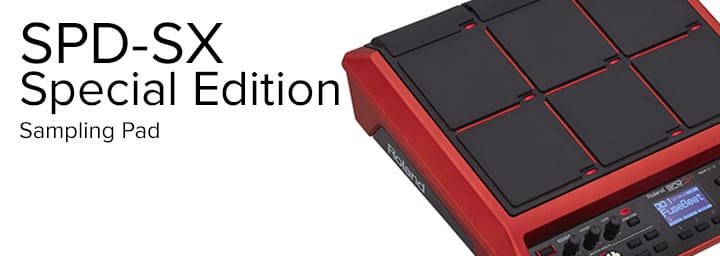Triggering Samples
Triggering WAV samples is both creative and musical with the SPD-SX.
Each pad or external trigger on the SPD-SX can have it’s own playback properties. These include:
Volume
Pan-where in the stereo image-Left to right
Pitch
Direction-forward or reverse
Play mode-single, loop, phrase
The first ones are self-explanatory so let’s look at the last one; the play mode.
PLAY MODE
When performing with samples, it’s possible that each and every sample of a kit will need to be played differently.
There are templates already made to help you with this decision.
The playing templates in the SPD-SX are:
SINGLE– Plays the sample once from beginning to end then stops-great for percussive one-shot hits, vocal samples and special effects.
PHRASE– Starts and stops the sample with alternating hits-useful for backing tracks or sounds where you may want to play for different lengths each time
LOOP– Plays the sample repeatedly until hit again. You can also choose several fixed loop lengths of 2, 4 and 8. In these cases the loop with stop once the number of loops has been reached. Looping is ideal for ambient sounds and percussion rhythm parts that may run for bars or under the entire song.
Other options here are:
DYNAMICS- Turn this on for velocity sensitive triggering Ideal for percussion. Turn off when you want consistency when triggering so sounds playback at exactly the same volume each time.
POLY/MONO
In poly mode, sound on sound layering is possible.
In mono mode, each new triggered sample will cut-off the previous one.
Mono mode is great for making kick drums sound cleaner as it eliminates any overhang, which tends to muddy things up.
TIP: Avoid Voice-robbing!
Use mono mode when you need to conserve playback voices- The SPD-SX can play eight simultaneous stereo samples (16 voices).
Once the maximum number of voices is reached, it will ‘rob’ a voice from another currently playing sound to allow the new one to play. This might just be the first one you triggered ie: The click or backing track
Make sure that sounds that don’t need to play on top of themselves are set to MONO play mode to free up voices for other important samples!
Pad Interaction
Sometimes you need samples to switch off when another one starts and there are times when you need several samples to start at precisely the same time.
This is where two special functions come in, mute grouping and pad-linking.
Mute Groups
SPD-SX Pads assigned to mute groups play in an either/or mode.
This means they will not play simultaneously. This is very useful if you want for example, three pads assigned to three different verse samples that never play together.
Hit pad 1 to start the first sample, hit pad 2 to switch off the first sample and play the second and so on.
You can have any pad or external trigger assigned to any of the 9 mute groups that switch perfectly without the need for you to hit each pad to stop it before triggering the new pad.
Here’s how to assign a pad to a mute group:
1. Press MENU–PAD–MAIN
2. Select or hit the pad and choose which mute group you want it assigned to
Keep in mind pads assigned to different mute groups can still play on top of one another so you can create some very interesting arrangements using mute groups.
Pad-Linking
Use the SPD-SX pad-link function in any situation where you want two sounds to play at exactly the same time with only a single hit.
An example of this could be a metronome click track on one pad routed to headphones and the matching music backing track on another pad routed to headphones and main outs.
They will play perfectly in-sync all the way through without you having to hit two pads at exactly the same time.
Here’s how to link pads:
1. Press MENU–KIT–COMMON
2. Use the PAD LINK setting to choose which pads are linked.
Pad linking is bi-directional meaning triggering either of the linked pads will play both samples.
Tip: Use the pad-link feature to help you play tighter with loops. Create a separate click for the loop then route it to headphones only and pad-link it to the loop.
Related Articles
Related Products




